Lettrism
Maurice Lemaitre
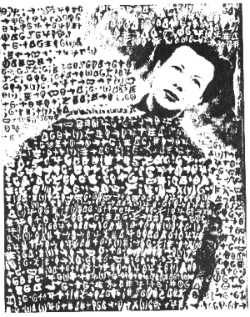
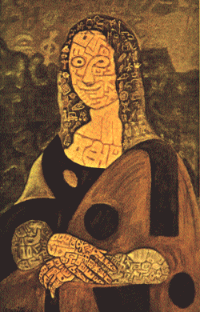 Isidore Isou, Amos
(1953).
Isidore Isou, Amos
(1953).
Lettrism, founded in the late forties by Isidore Isou
[1], was as much a reaction against Andre Breton's
dictatorial control of Surrealism (and Surrealism's movement away from its
conceptual origins in Dada towards that of
mysticism), as it was an attempt the get poetry back into people's lives and on
the 'hit parade.' In his attempt to rewrite all of human knowledge, Isou had
discovered that the evolution of any art was characterized by two phases:
'amplic' and 'chiseling.' In following the development of the art of poetry for
example, Isou saw the Lettrist at the end of a long chiseling phase which had
begun with Baudelaire reducing narrative in his poetry to anecdote, then
Rimbaud disregarding anecdote for lines and words, Mallarmé reducing
words to sound and spaces (particularly in Un Coup de Des), and finally
the Dadaists destroyed the word altogether. Isou saw at the end of this phase
the new beginnings of an amplic stage for culture, from which a whole host of
new arts, ways of working, and social institutions would eventually spring,
with Isou at the center of all creative work.
The Lettrist worked on the level of the
letter at the heart of what they believed to be an experiential language that
was to be the basis of their new culture. Their Lexique Des Lettres
Nouvelles, for example was a sonic alphabet of a 130 or so sounds from
which a new natural language was to spring from and from which they composed
their poetry. Isou along with his chief lieutenant, Maurice Lemaitre, worked
out a notational style that resembled that of traditional, 'common-practice'
music, sometimes even with staffs, bar lines, and dynamic markings. Lettrist
poetry was also often performed by choral groups.
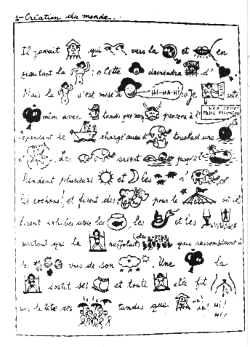 Isidore Isou, The
God's Diaries (1950)
Isidore Isou, The
God's Diaries (1950)
Much of the bulk of Lettrist activities moved
toward visual manifestations of expression in the later years, with a great
deal of activity in painting and film [2]. Splinter
groups and expunged individuals groups such as the Ultralettrists, evolved into
a political manifestation, first the Lettrist International in 1952 (Gil J.
Wolman, Jean-Louis Brau, Guy Debord, and Serge Berna) and then Situationism
(1957-1972). Much of the current interest in Lettrism comes from its connection
with the Situationists.
The Situationist International had its
origins in 1956 at the First World Congress of Liberated Artist. It was a
meeting of several artists who had belonged a number of obscure radical
European art groups in the fifties such as COBRA, a Belgian group of subversive
Surrealists (another anti-Breton faction); The International Movement For An
Imaginist Bauhaus -- an anti-Max Bill group who were upset that the Bauhaus had
been restructured by Bill to be an academy where only technical instruction was
to be given; and members from the Lettrist International, were Situationism
first saw the light of day.
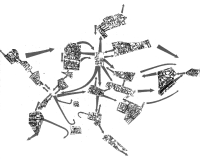 The
Situationist International (SI) analysis about the rise of spectacle
politics [3] and its subsequent effects on mass
culture that has deep resonances with today's conceptions of hyperreality and
postmodernism. The SI (and it's earlier manifestation as the Lettrist
International (LI)) proposed a number of social critiques or 'situations' by
which a new socio-political organization of world culture based around the
ever-changing principles of contemporary art would take the place of the
materialistic, worn-out economies of the past. Particularly, they proposed the
concept of Unitary Urbanism based in the function and functionality of
urban space as determined by psychogeography -- the study of the precise
laws and specific effects of the geographical environment, consciously
organized or not, on the emotions and behavior of individuals living in that
environment.
The
Situationist International (SI) analysis about the rise of spectacle
politics [3] and its subsequent effects on mass
culture that has deep resonances with today's conceptions of hyperreality and
postmodernism. The SI (and it's earlier manifestation as the Lettrist
International (LI)) proposed a number of social critiques or 'situations' by
which a new socio-political organization of world culture based around the
ever-changing principles of contemporary art would take the place of the
materialistic, worn-out economies of the past. Particularly, they proposed the
concept of Unitary Urbanism based in the function and functionality of
urban space as determined by psychogeography -- the study of the precise
laws and specific effects of the geographical environment, consciously
organized or not, on the emotions and behavior of individuals living in that
environment.
The Situationists wanted a total
transformation of the world into one that would exist in a constant state of
revolution and newness, just as F. T. Marinetti had proposed a half a century
before with his founding manifesto of Futurism. The two tools to perform such a
transformation, were developed by the LI as détournement ('a
theft of aesthetic artifacts from the Old World') and dérive ('to
drift -- opening one's consciousness to the unconsciousness of urban space').
The détournement according to Guy Debord and Gil J. Wolman, in
their 1956 essay was to replace art. The dérive was to replace
work: What the group meant to practice, Dubord said in 1959, looking back,
was "a role of pure consumption" -- the total consumption of all the
images and words of the past, the total consumption of the groups surroundings,
and ultimately the total consumption "of its time"
[4]. Their analysis of a world existing as
banalities which can then be removed from their references to be reconstructed
as a harmony based in art harks back to Kurt
Schwitters and his Merzbau.
By the nineteen sixties, the
Situationists had faded into obscurity as a result of their own over
self-involvement in pure consumption and had committed themselves to a life
of permanent novelty. After many purges and personality conflicts, there
was little left of the SI except for a small group centered around Guy Dubord,
their chief theorist. Occasionally there was a mimeographed newsletter which
gave an indication that the group still existed as a functioning entity. They
would have probably slipped off into complete oblivion like so many other
undistinguished radical art movements of this century, except for the notoriety
brought to them by an odd set of circumstances.
In 1966, largely out of apathy from their
fellow classmates, a group of five students gained posts in the student
government at the University of Strasbourg. Bored with what they saw of
'relevant' education as well as the typical youth-group politics of the times,
they got in contact with what remained of the Situationist International
through their old post office box. They asked them what they could do to break
the strangle-hold of apathy, banality and stagnation that they saw all around
them. After repeated pleas to the SI who were neither interested nor
responsive, the students were finally told to go write a critique of their
status as students and the society they represented. Unable to do such a
critique, an SI member, Mustapha Khayati, eventually wrote the critique for
them.
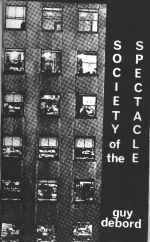 On the Poverty
of Student Life [5] concentrated a decade of
Situationist thoughts, values, and theories into a twenty-eight page scathing
satire against the university as being an institutionalized form of ignorance
and made light of its professors, the government, the church, the family, the
traditional left, the fascist right, the work ethic, modern culture, etc. It
proposed to create at last a situation that goes beyond the point of no
return.
On the Poverty
of Student Life [5] concentrated a decade of
Situationist thoughts, values, and theories into a twenty-eight page scathing
satire against the university as being an institutionalized form of ignorance
and made light of its professors, the government, the church, the family, the
traditional left, the fascist right, the work ethic, modern culture, etc. It
proposed to create at last a situation that goes beyond the point of no
return.
Of course, all those ridiculed by the
publication, denounced the act of its publication as a misappropriation of
public funds and the betrayal of positions of public trust. The student
leaders were summarily removed from their positions by a pernicious
implementation of 'the rules' typical of those in power who are laughed at.
However, this reactionary response created a situation and a chain of
events which resulted in the Paris Strike of 1968. This general student-worker
strike shutdown the city for several days and was the most serious crises to
face the French government since World War II [6].
The analysis of the '68 Strike's
existence and failure has colored a major thread in French thought since that
time [7]. However, a more well-known connection
popularized in Greil Marcus's study of a 'secret history' of influences
(beginning in the Middle Ages and working up through Dada) is where the
Situationists are connected to Punk through Malcolm MacLaren's support of
situ-inspired activities dating from the Paris uprising. MacLaren's later
creation of the Sex Pistols, the rock band to destroy rock 'n roll, is seen as
a translation of the Situationist point of view, as well as their slogans and
iconography into a pop music venue [8]. This
connection whether metaphorical or actual has inspired curiosity and
controversy [9], and is particularly ironic
considering that the main intentions of the SI during their brief moment in
time, was to mostly sit around a lot in bars and consume their environment.
However, such interest has let to major retrospectives of their work, as well
as all of their esoteric publications becoming readily available in several
different translations, including a large archival
site.

Last Modified 14 April 2011

 Isidore Isou, Amos
(1953).
Isidore Isou, Amos
(1953).  Isidore Isou, The
God's Diaries (1950)
Isidore Isou, The
God's Diaries (1950) 
